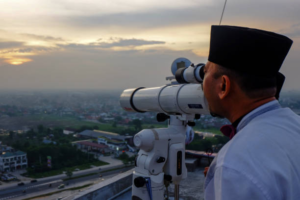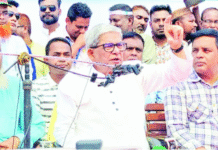
by Dr Sharif As-Saber
This year while some suggest that it is July 9, others prescribe on July 10, the day for the celebration of the Eidul Adha, Islam’s second most important festival.
Muslims follow lunar calendar to fix dates for some of their key religious activities such as commencement of the month-long fasting, the Ramadan and two Eids – Eid ul Fitre, the end of Ramadan festival and Eidul Adha, the Eid following the annual Haj, the pilgrimage in Mecca.
The Moonsighting: ‘Positional Astronomy’ Vs. ’Observation Method’
However, determination of exact dates for each of these events has never been easy nor without controversy. There has been ongoing debate among the Islamic scholars about the sighting or positioning of the new moon and its implications for commencement of a major activity such as Ramadan and/or celebrations of two Eids – Eid ul Fitre and Eid ul Adha.
Using ‘positional astronomy’, some scholars rely on the ‘scientific method’ to determine the exact position of the new moon without physically sighting the same and yet there are many who rely on bare eyes to physically sight the new moon before commencing the fasting month or celebrating the Eid. The physical sighting exercise is known as the ‘observation method’. Although, from a broader Islamic juristic perspective, it is not easy to draw a conclusion on this matter, the issue surely warrants thoughtful and constructive deliberations to resolve the controversy and confusions once and for all.
In this regard, I would like to refer to a Sahih Hadith (Saying of the Prophet Muhammad, RA) from Bukhari Shareef. According to Imam Bukhari, the author of the Sahi Hadith, who is regarded as the most authentic Muslim scholar to have recorded most accurately the words/instructions of the Prophet Muhammad (RA), says: ‘Do not begin the fast until you see the new moon, and do not break the fast (at the end of Ramadan) until you see the new moon. If the new moon is obscured from you, then work out (when it should be).’ (AL-MUWATTA, Al Bukhari 18.1.1).
Quoted above, the last sentence of this Hadith is significant in the sense that it insists if the new moon is not be sighted with bare eyes because of clouds, sandstorm, haze or any other obstacles, the faithfuls should be ‘work(ing) out’ the best and the most scientific way possible to determine the moon’s position. If for reason it is still not possible to work it out, it is advisable to wait for an additional day before celebrating the Eid and/or commencing the month of Ramadan. This is the most authentic and important Hadith that clearly advises how best to determine new moon’s position/appearance.
In essence, the Hadith requires Muslims to ‘work out’ the time of the appearance of the new moon (if it is mature enough to be sighted with bare eyes). That means, if we are sure enough that the new moon has already been born and gained enough maturity, we may start fasting or celebrate Eid whichever is the case.
During the early days of Islam, there was no other way but to sight the new moon with bare eyes. As a result, if the moon could not be sighted with bare eyes in an overcast evening, they had to wait for an extra day to make it sure that the new moon was already in the sky. Please note, on the 30th day, there is no requirement even to sight the new moon. That means, the emphasis is not on the mere sighting of the moon, but the confirmation of the moon being in the sky in a certain position (even if it is still hidden under the clouds)!
These days, with the help of science, it is possible to know the exact position and time of the appearance/sighting of the new moon long before the actual day of such sighting. Therefore, with the help of science, ‘working out’ or determining the actual position of the new moon is possible without even looking at the sky which, in turn, could serve as the basis for starting fast or celebrating Eid. It does not contradict the above-mentioned Hadith or the instruction by the prophet.
Science is an aid and not an adversary
With few exceptions, we must not treat science as an adversary to our religious belief system. Science and scientific knowledge are not alien to the planet created by Allah. On the contrary, science has allowed us to unlock and understand a lot of religious mysteries. Moreover, if we observe carefully, we will see that we rely heavily on science to perform many of our daily religious rituals. For example, we use watches to perform daily prayers and to start and break the fast during the month of Ramadan. In addition, the use of high-powered binoculars and telescopes is nothing new among the followers of the ‘observation’ method’, who are, in essence, utilising scientific means to maintain many of the Islamic rituals including the sighting of the new moon. Hence, science is already in use in many aspects of observance of our religious practices including observing the moon and to celebrate other religious and cultural festivities.
The good thing about relying on science is, it would allow the global Islamic community to perform the Eid and commence the fasting in a uniform, systematic, timely and uncontroversial manner. It will also eliminate within a country any differences and/or confusions among the Muslims in choosing the day to commence fasting and/or celebrate Eid especially in countries such as Australia, UK, and the US where Muslims are minority and where confusions with moon sighting (Positional Astronomy Vs. Observation Method), prevent the Muslims to observe their most important ritual such as Ramadan and celebrate Eids together on the same day.
Furthermore, in some of these non-Muslim countries where now sizable number of Muslims reside that do entitle them to legitimately request their respective governments to have at least one of their major festivities, say Eid ul Fire, declared a public holiday. However, differences of opinions with moon-sighting methods prevent Muslims in these countries to secure a fixed day as the Eid day as a public holiday.
The case of Bangladesh
In Bangladesh, the responsibility of announcing the moon sighting rests with the National Moon Sighting Committee, headed by the Minister in charge of the Ministry of Religious Affairs. The Director General of the Islamic Foundation is the Member Secretary of this committee. This 18-member committee includes, among others, Chairman of Bangladesh Space Research and Remote Sensing Institute, Director of Bangladesh Meteorological Department and Khatib (Imam) of Baitul Mukarram Mosque, Bangladesh’s largest mosque in Dhaka, the capital city.
The Islamic Foundation makes use of scientific equipment including high-powered telescope to watch and locate the new moon. In 2019, the Foundation also bought an optical theodolite device. Using this device, the staff of the Islamic Foundation try to watch the new moon from the roof of a multi-storey building next to the Baitul Mukarram mosque.
In each district, a committee headed by the local Deputy Commissioner (District Administrator) and comprising of district officials from the Islamic Foundation also collect moon sighting information. Based on the information, the committee holds a press conference and announces the sighting or non-sighting of the moon and determine the day of Eid and the start of the month of Ramadan.
Using the scientific method, both SPARRSO and Bangladesh Meteorological Department (BMD) collect the positioning data of the new moon and present them to the moon sighting committee. Accordingly, they routinely issue instructions to their meteorologists to watch the new moon and collect relevant data such as the age of the moon, its specific position including its azimuth and altitude, and the time of the moonset. Although the data are presented to the moon sighting committee, these are not considered by the committee. Final decision of moon sighting is based on the so-called ‘observation method’.
In many countries, including Europe and China, lunar positions are determined by using the scientific method.
The United Nations Headquarters in New York determines Eid days (both Eid ul Fitre and Eid ul Adha) based on astronomical data and includes them in its official holiday calendar at the beginning of the year.
Apply ‘Qiyas’ and ‘Ijma’
This ongoing ‘moon sighting’ controversy could easily be referred to as a hollow ‘moon fighting’ exercise. To remove the controversy, Muslims must abide by Islam’s much revered ‘Qiyas’ system (instructions obtained from the holy Quran and Hadith) and use the methods of ‘Ijma’ (consensus) to resolve the issue once for all, preferably, by relying on a method which is scientifically embedded and less controversial and thereby, agree ahead of time, on fixed dates to observe three of their major events/festivals – Ramadan, Eid ul Fitre and Ei dul Adha. This will also help Muslims in every country especially in non-Muslim countries where they are in sizable numbers to secure public holidays from their respective governments, if not for both the Eids, at least for the Eid ul Fitre, the end of Ramadan festival and celebrate the occasion, together on the same day.










An excellent and timely write up! It could be an eye opener for many. Thanks to the author for presenting the issue in an informative and balanced manner.